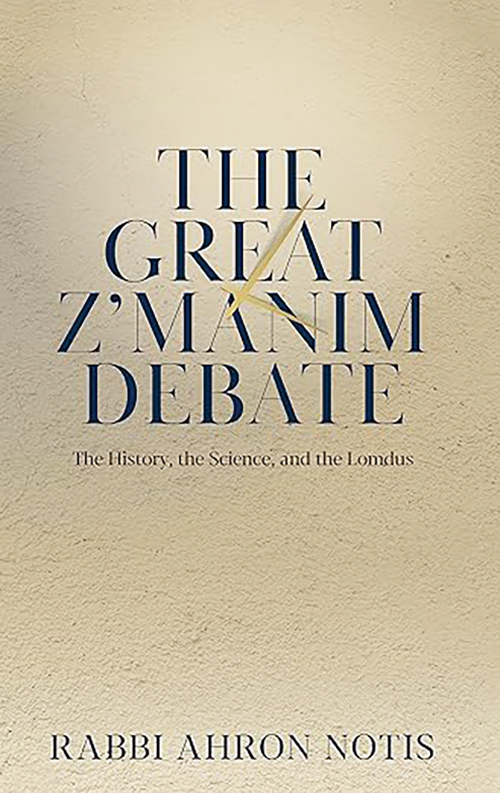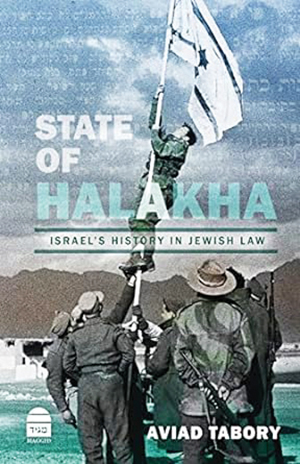Reviewing: “The Great Z’manim Debate: The History, The Science, and The Lomdus” by Rabbi Ahron Notis. Mosaica Press. 2022. English. Hardcover. 188 pages. ISBN-13:
978-1957579122.

If you go to the MyZmanim website and click on “Extended Daily Zmanim,” you will find close to 40 different times and halachic categories during the day. The nature of time is engrained in the daily life of an observant Jew. If you ask a person on the street what time sunset is, they might be able to guess within 45 minutes or so. Ask the average Orthodox person what time sunset is, and they can likely tell you within a few minutes.
In “The Great Z’manim Debate: The History, The Science, and The Lomdus,” Rabbi Ahron Notis has written a fascinating and engaging read about the nature of time and how it’s dealt with in halacha.
One area the book deals with is the fluctuating length of bein hashemashos (twilight). He writes that when the Gemara sets a length for how long twilight is, they were referring to their locations in Bavel and Israel. Yet when trying to coordinate the length of time for twilight in other locales, they do not synchronize.
He quotes the Minchas Kohen, who felt that the amount of time for bein hashemashos was indeed not the same everywhere, but was reluctant to express such a novel idea, even though he knew it was undeniably true.
In many communities, members of Modern Orthodox shuls may already be home checking their emails on a Motzei Shabbos, while those who daven in the kollel are just starting Maariv. In ”The Great Z’manim Debate,” Rabbi Notis shows how in fact, the kollel may be davening much later than necessary.
The overall issue is that the nature of zmanim is so engaged in our lives, that any innovation is treated with suspicion. Many of the ideas Rabbi Notis proposes may seem wild, but are, in fact, quite sound. Of course, it’s ideas like those that got Rabbi Slifkin thrown into cherem.
Rabbi Notis admits he doesn’t expect communities to change their davening times. But what the book shows is that it’s important to understand the underlying concepts around halachic time—given that it impacts every minute of our lives.
Reviewing: “State of Halakha: Israel’s History in Jewish Law” by Aviad Tabory. Maggid Books. 2023. English. Hardcover. 304 pages. ISBN-13: 978-1592645534.

In the almost 2,000 years between the destruction of the Second Temple and the founding of the State of Israel, there was not much written when it came to the land of Israel and halacha. Things were about as static as they could be. But all that changed in 1948. And in the 75 years since then, the floodgates have opened.
In ”State of Halakha: Israel’s History in Jewish Law,” Rabbi Aviad Tabory of Yeshivat Eretz HaTzvi has written a thoroughly fascinating and important book about 34 consequential events between 1948 and 2019, and their halachic ramifications.
While often seen as a staunchly secular Zionist, Tabory writes that David Ben-Gurion established the State of Israel on Friday, May 14, 1948, even though the British Mandate expired on May 15, in order not to violate the Sabbath. The date of Yom Ha’atzmaut was based upon the consideration of not violating Shabbat.
One of the questions the book deals with is one that almost led to anarchy in the young state: reparations from Germany. Rabbi Joseph Soloveitchik was originally against the idea. But the book quotes Rav Hershel Schachter, who said that in his later years, Rav Soloveitchik admitted that he may have been mistaken in opposing reparations, as they saved the Jewish State.
Every chapter in the book is a fascinating analysis, and each of them has repercussions to this very day—from trading land for peace, determining who is a Jew, drafting of Torah scholars, conversion, and more.
There are challenges, and many of these areas were never resolved in the preceding millennia. But Rabbi Tabory shows the greatness of the many rabbis who stepped up to the plate and answered these very difficult questions.
Reviewing: “Challenging Assumptions” by Rabbi Moshe Kurtz. Mosaica Press. 2023. English. Hardcover. 220 pages. ISBN-13: 978-1957579955.
Whenever he teaches a controversial topic, Rabbi Moshe Kurtz asks his audience: “Would you prefer I sugarcoat it for you or would you like to know what the source actually says?” And he has never received a request to omit a controversial question, even if some find it objectionable.
In “Challenging Assumptions,” Kurtz details many pressing issues Orthodox society is grappling with today. Some of them include cross-dressing and cross-conduct, harmful speech, lying in the course of kiruv rechokim, and Torah Umadda issues.
For those in Jewish education and outreach, there is often a desire to showcase the positive aspects of Judaism by sugarcoating things. This can extend to actually using false pretenses in the course of outreach.
Kurtz explores that question and, in fact, quotes noted posek Rav Yitzak Zilberstein who (surprisingly to me and others) says that there is no issue with deceiving someone in order to bring them close to God, as long as one can ensure that they will not be discovered.
Whether one decides to use such a dispensation, the author concludes this topic by noting that it’s only through honesty and trust that rabbis and teachers can aspire for their students and congregants to remain committed to a true Torah life.
Those in kiruv are often reluctant to deal with uncomfortable topics. But here, Kurtz shows that there is no conflict in tackling these difficult contemporary questions in Judaism, when they are approached in an intellectually honest manner.
With rabbinic ordination from YU, one might expect Kurtz to wholeheartedly toe the YU party line around the concept of Torah UMadda. But he interestingly writes that recently, Torah UMadda has colloquially devolved into the “tikkun olam” of Modern Orthodoxy, a motto so flexible and amorphous that it has regrettably become next to meaningless. Fighting words indeed.
Kurtz has written a book that will challenge many assumptions and is a most interesting read. No sugarcoating was added to this book.
Ben Rothke lives in New Jersey and works in the information security field. He reviews books on religion, technology, philosophy and science. Follow him on Twitter at @benrothke. His new book was just published: “The Definitive Guide to PCI DSS Version 4: Documentation, Compliance, and Management.”













